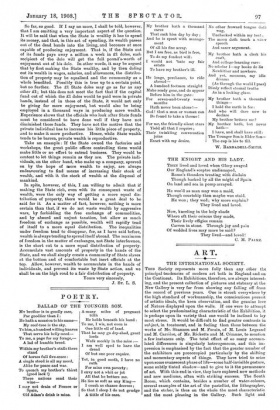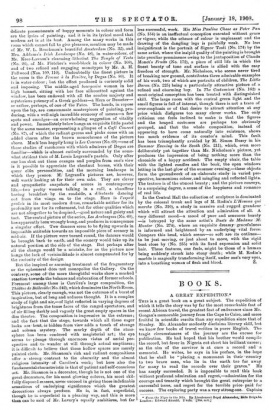ART.
THE INTERNATIONAL SOCIETY.
THIS Society represents more fully than any other the principal tendencies of modern art both in England and on the Continent. Its Exhibitions, therefore, are always interest- ing, and the present collection of pictures and statuary at the New Gallery is very far from showing any falling off from the record of previous years. One is struck everywhere by the high standard of workmanship, the conscientious pursuit of artistic ideals, the keen observation, and the genuine love of Nature displayed upon the walls. If one were to attempt to select the predominating characteristic of the Exhibition, it is perhaps upon its variety that one would be inclined to lay most stress. It would be difficult to find greater contrasts in subject, in treatment, and in feeling than those between the works of Mr. Shannon and M. Forain, of M. Louis Legrand and M. Carriere, of Mr. Ricketts and M. Cezanne, to mention a few instances only. The total effect of so many accumu- lated differences is singularly heterogeneous, and this im- pression is emphasised by the fact that the greater number of the exhibitors are preoccupied particularly by the shifting and momentary aspects of things. They have tried to seize upon some evanescent phase of life—some half-invisible gesture, some subtly tinted shadow—and to give to it the permanence of art. With this end in view, they have explored new methods and new mediums, often with striking success. The South Room, which contains, besides a number of water-colours, several examples of the art of the pastellist, the lithographer, and the etcher, is thus on the whole the most char a.cteristie and the most pleasing in the Gallery. Such light . and delicate presentments of happy monients in colour and form are the lyrics of painting; and it is in its lyrical mood that modern. art is at its best. Among the many works in this room which cannotfail to give pleasure, mention may be made of Mr. W. L. Bruckman's beautiful Amsterdam (No. 32), and
Mrs. Addams's Irish Landscape (No. 48), in water-colour, of Mr. Kerr‘Lawson's -charming :lithotint The Temple of Vesta (No. 26), of Mr. Fletcher's wood-block in colour (No. 108), and of two .refined 'and engaging monotypes by Mr. A. H. Fullwood (Nos. 109, 110). Undoubtedly the finest picture in the room is the Femme a is Fenetre, by Degas (No. 86). It 13 in water-colour ; but the effect produced is curiously solid and imposing. The middle-aged bourgeoise woman in her. high bonnet, sitting with her face silhouetted against the window, has been -endowed with all the sombre majesty and mysterious potency of a Greek goddess—a Hera or Demeter— or rather, perhaps, of one of the Fates. The hands, in repose upon the lap, are consummate masterpieces of painting, pro- ducing; with a well-nigh incredible economy of means—a few spots and smudges—an overwhelming suggestion of vitality and power. Immediately below hangs an exquisite little pastel by the same master, representing a glimpse of a Café Concert (No. 87), of which the radiant greens and pinks come with an added charm after the brown monochrome of the picture above. Muchness happily hung is Les Courses (No. 69)—one of those studies of racehorses with which admirers of Degas are familiar—whielt-is--almost entirely surrounded by the some- what strident tints of--M. Louis Legrand's pastels. Only after one has shut -out these oranges and purples from one's view is it possible to appreciate the chestnut horses, with their queer elfin personalities, and the morning landscape in which they prance. Mi Legrand's pictures are, however, well wortli'looking.ab for their own sake. They are clever and sympathetic snapshobs of scenes in contemporary life,—two pretty women talking in a cafe, a chauffeur having breakfast • by -the.. roadside, a d6butante dancing out from the wings on. to the stage. Here is l'esprit gaulois in its most modern dress, remarkable neither for its profundity nor for its refinement, but for other qualities which are not altogether to be despised,—good nature and gaiety and tact. The central piettrre of the series, Les Arabesques (No. 60), has apparently been-wrongly hung, and produces in consequence a singular effect. Twir 'dancers seem to be flying upwards in impossible attitude 'towards an impossible piece of scenery in mid-air. If the picture were turned round, the dancers would be brought liack' te earth; and the scenery would take up its natural position at the side of the stage. But perhaps after all the change would be- a - mistake, for as the picture now bangs the lack of verisimilitude is almost compensated for by the curiosity of the design'.
But the inspired or amusing treatment of the fragmentary or the ephemeral does -not monopolise the Gallery. On the contrary, some Orthe more thoughtful works show a marked reaetien 'towards the balance and elaboration of former schools. Foremost' among • these is (Jarriere's large composition, the Thijdtre de Bellevitle< No. 242)-, which dominates the North Room. This picture, clearly enough, was-not the outcome of a burst of inspiration, but of long- and arduous thought. It is a complex study of light and nit,-,--of light reflected in varying degrees of brightness from the tense faces of the ranged spectators, and of air filling darkly,and vaguely the great empty spaces in the dim theatre. The composition is impressive in the extreme ; and the -fact that the stage; towards which all these eager looks are bent, is. hidden from view adds a touch of strange and solemn . mystery. The murky depth of the atmo- sphere has been- rendered with magisterial art ; the eye seems to plunge through enormous vistas of aerial per- spective and to wander at will through actual emptiness ; it is difficult to believe that those hollow spaces are merely painted cloth: Mr. Shannon's rich and radiant compositions offer a' strong,: contrast to the obscurity and the almost religious intensity,' of, Carriere's work; but here also - the fundamental characteristic is that of patient and self-conscious art: Mr. Shannon is a decorator, though he is not one of the great decorators, for 'his most glowing colours, his most skil- fully disposed -masses, never succeed. in giving those indefinable sensations of underlying significance which the greatest decorations always produce. He is, in fact, superficial, though he is ,superficial in a pleasing way, and this is more than can be said of Mr. Lavery's equally ambitious, but far- ar less leas successful, work. His Miss Pauline Chase as Peter Pan (No. 154) is an ineffectual conception executed without grace or vigour, while the scheme of colour is unpleasant and the drawing of the dangling 'legs is painfully weak. N'o less insignificant is the portrait of Signor Testi (No. 174) by the same artist, where the insipid quality of the painting is brought into peculiar prominence owing to the juxtaposition of Claude Monet's Fruits (No. 172), a piece of still life in -which the finest beauty of tone and surface is allied with the easy freedom of strength.. Mr. Nicholson, who seems never tired of breaking new ground, contributes three admirable examples of his work, two of which are portraits of children, The Little Baron (No. 225) being a particularly attractive picture of a refined and :charming boy. In The Costumiers (No. 162) a most original conception has been treated 'with distinguished skill. The large -room with the central 'green light and the small figures is full of interest, though. there is not a trace of over-emphasis or of that desire to attract • attention at any price which disfigures too many clever works. The only criticism one feels inclined to make is that the figures and the heaped costumes are perhaps too obviously grouped, and that the whole composition, instead of appearing . to have come naturally into existence, shows too much evidence of its creator's mind. This fault has been triumphantly avoided by M. Simon Bassy • in his Summer Evening in the South (No. 211), which, even more deliberately put together- than Mr. NichoLson's picture, yet produces the impression, of being nothing more than the chronicle of a happy accident: The empty chair, the -table with the lighted. candles and the book, the open • windows letting in the lad glow of the summer evening,--these objects form the -groundwork of. an ■elaborate : study in varied per. spedtive, harmonious colour, and mingling and reflected-lights. The texture is of the utmost beauty ; and the picture 'conveys, to a surprising degree,- a sense of the happiness and romance of real life.
In the Central Hall the collection of sculpture is dominated by the colossal trunk and legs of M. Rodin's L' Homme qui marche (No. 310), a study in massive and -rugged grandeur which will attract the attention and admiration of all. A very different mood—a mood of pure and sensuous ,beauty —is betrayed by the same artist's Baste de Madame ...PE Hunter (No. 270, • where an exquisite dreamy': gracefulness is informed and heightened by an underlying vital force: Compare this head, which seems—so soft are, its outlines— to be just. moving, or just' about to move, with the rigid bust close by (No. 255) with its fixed expression and solid hair. These features, one feels, might be -those of a human being suddenly struck into stony • death ; while M. Rodin's marble is magically transforming itself, under one's very 'eyes, into a breathing woman-of flesh and blood. Z.







































 Previous page
Previous page